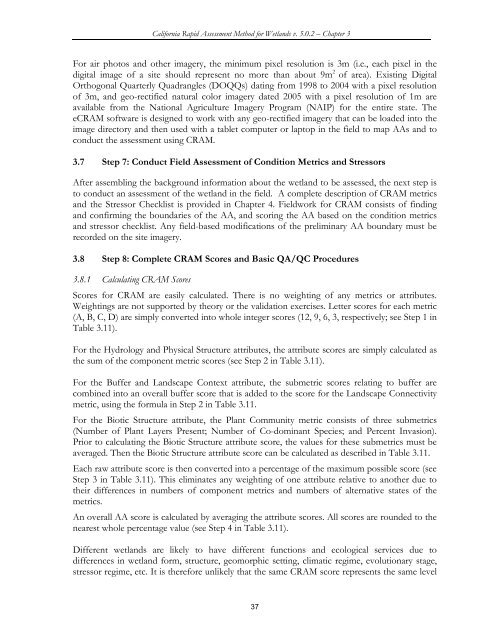(CRAM) For Wetlands User's Manual Version 5.0.2
(CRAM) For Wetlands User's Manual Version 5.0.2
(CRAM) For Wetlands User's Manual Version 5.0.2
You also want an ePaper? Increase the reach of your titles
YUMPU automatically turns print PDFs into web optimized ePapers that Google loves.
California Rapid Assessment Method for <strong>Wetlands</strong> v. <strong>5.0.2</strong> – Chapter 3<br />
<strong>For</strong> air photos and other imagery, the minimum pixel resolution is 3m (i.e., each pixel in the<br />
digital image of a site should represent no more than about 9m 2 of area). Existing Digital<br />
Orthogonal Quarterly Quadrangles (DOQQs) dating from 1998 to 2004 with a pixel resolution<br />
of 3m, and geo-rectified natural color imagery dated 2005 with a pixel resolution of 1m are<br />
available from the National Agriculture Imagery Program (NAIP) for the entire state. The<br />
e<strong>CRAM</strong> software is designed to work with any geo-rectified imagery that can be loaded into the<br />
image directory and then used with a tablet computer or laptop in the field to map AAs and to<br />
conduct the assessment using <strong>CRAM</strong>.<br />
3.7 Step 7: Conduct Field Assessment of Condition Metrics and Stressors<br />
After assembling the background information about the wetland to be assessed, the next step is<br />
to conduct an assessment of the wetland in the field. A complete description of <strong>CRAM</strong> metrics<br />
and the Stressor Checklist is provided in Chapter 4. Fieldwork for <strong>CRAM</strong> consists of finding<br />
and confirming the boundaries of the AA, and scoring the AA based on the condition metrics<br />
and stressor checklist. Any field-based modifications of the preliminary AA boundary must be<br />
recorded on the site imagery.<br />
3.8 Step 8: Complete <strong>CRAM</strong> Scores and Basic QA/QC Procedures<br />
3.8.1 Calculating <strong>CRAM</strong> Scores<br />
Scores for <strong>CRAM</strong> are easily calculated. There is no weighting of any metrics or attributes.<br />
Weightings are not supported by theory or the validation exercises. Letter scores for each metric<br />
(A, B, C, D) are simply converted into whole integer scores (12, 9, 6, 3, respectively; see Step 1 in<br />
Table 3.11).<br />
<strong>For</strong> the Hydrology and Physical Structure attributes, the attribute scores are simply calculated as<br />
the sum of the component metric scores (see Step 2 in Table 3.11).<br />
<strong>For</strong> the Buffer and Landscape Context attribute, the submetric scores relating to buffer are<br />
combined into an overall buffer score that is added to the score for the Landscape Connectivity<br />
metric, using the formula in Step 2 in Table 3.11.<br />
<strong>For</strong> the Biotic Structure attribute, the Plant Community metric consists of three submetrics<br />
(Number of Plant Layers Present; Number of Co-dominant Species; and Percent Invasion).<br />
Prior to calculating the Biotic Structure attribute score, the values for these submetrics must be<br />
averaged. Then the Biotic Structure attribute score can be calculated as described in Table 3.11.<br />
Each raw attribute score is then converted into a percentage of the maximum possible score (see<br />
Step 3 in Table 3.11). This eliminates any weighting of one attribute relative to another due to<br />
their differences in numbers of component metrics and numbers of alternative states of the<br />
metrics.<br />
An overall AA score is calculated by averaging the attribute scores. All scores are rounded to the<br />
nearest whole percentage value (see Step 4 in Table 3.11).<br />
Different wetlands are likely to have different functions and ecological services due to<br />
differences in wetland form, structure, geomorphic setting, climatic regime, evolutionary stage,<br />
stressor regime, etc. It is therefore unlikely that the same <strong>CRAM</strong> score represents the same level<br />
37















